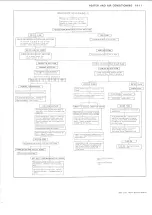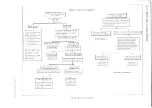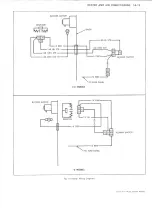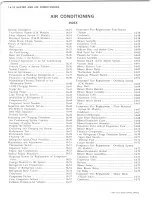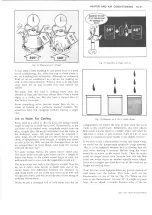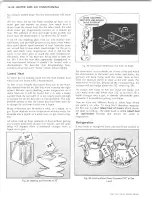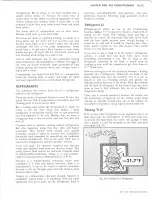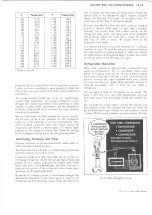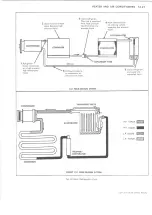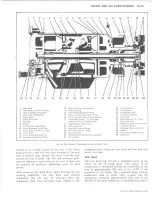
1A-24 HEATER A N D AIR C O N D I T IO N I N G
ra3S2Qp3pj|3
Fig. 3 1 - R e u s in g R e fr ig e r a n t
That is where we find the biggest difference between the
old icebox and the modern refrigerator. We used to put
in new ice to replace that lost by melting. Now we use
the same refrigerant over and over again.
We can change a vapor back into a liquid by chilling it,
or do the same thing with pressure. When we condense a
vapor we will find that the heat removed just exactly
equals the amount of heat that was necessary to make
the substance vaporize in the first place.
This is called the latent heat of vaporization - the heat
that apparently disappeared when a liquid boiled into a
vapor—again reappears - when that same vapor reverts
back into a liquid. It is just like putting air into a balloon
to expand it and then letting the same amount of air out
again to return the balloon to its original condition.
We know that any substance will condense at the same
temperature at which it boiled. This temperature point is
a clear-cut division like a fence. On one side, a substance
is a liquid. Immediately on the other side it is a vapor.
Whichever way a substance would go, from hot to cold
or cold to hot, it will change its character the moment it
crosses over the fence.
Water will boil at 212° under normal conditions.
Naturally, we expect steam to condense at the same
temperature. But whenever we put pressure on steam, it
doesn’t. It will condense at some temperature higher
than 212°. The greater the pressure, the higher the
boiling point and the temperature at which a vapor will
condense. This is the reason why pressure cookers cook
food faster, since the pressure on the water permits it to
boil out at a higher temperature.
We know that R-12
boils
at 21.7° below zero. A
thermometer will show us that the rising vapors, even
though they have soaked up lots of heat, are only slightly
warmer. But the vapors must be made warmer than the
room air if we expect heat to flow out of them. The
condensing point temperature must be above that of
room air or else the vapors won’t condense.
This is where pressure helps, with pressure, we can
compress the vapor, thereby concentrating the heat it
contains. When we concentrate heat in a vapor that way,
we increase the intensity of the heat or, we increase the
temperature, because temperature is merely a measure
ment of heat intensity (fig. 32).
Pressure in Refrigeration
Because we must use pressures and gauges in air
conditioning service, the following points are mentioned
so that we will all be talking about the same thing when
we speak of pressures.
All pressure, regardless of how it is produced, is
measured in pounds per square inch (psi).
Atmospheric Pressure is pressure exerted in every
direction by the weight of the atmosphere. At sea level
atmospheric pressure is 14.7 psi. At higher altitudes air
has less weight (lower psi).
Any pressure less than atmospheric (14.7) is known as a
partial vacuum or commonly called a vacuum. A perfect
vacuum or region of no pressure has never been
mechanically produced.
Gauge pressure is used in refrigeration work. Gauges are
calibrated in pounds (psi) of pressure and inches of
Mercury for vacuum. At sea level, "O " lbs. gauge
pressure is equivalent to 14.7 lbs. atmospheric pressure.
Pressure greater than atmospheric is measured in pounds
(psi) and pressure below atmospheric is measured in
inches of vacuum. The "O" on the gauge will always
correspond to the surrounding atmospheric pressure,
regardless of the elevation where the gauge is being
used.
Pressure-Temperature Relationships of R-12
A definite pressure and temperature relationship exists in
the case of liquid refrigerants and their saturated vapors.
Increasing the temperature of a substance causes it to
expand. When the substance is confined in a closed
container, the increase in temperature will be accompa
nied by an increase in pressure, even though no
mechanical device was used. For every temperature,
there will be a corresponsing pressure within the
container of refrigerant. A table of the temperature-
pressure relationship of R-12 is presented below.
Pressures are indicated in gauge pressure, either positive
pressure (above atmospheric) in pounds or negative
pressure (below atmospheric) in inches of vacuum.
Thus if a gauge is attached to a container of R-12 and
the room temperature is 70°, the gauge will register
approximately 70 psi pressure; in a 100° room, the
pressure would be 117 psi.
Pressure and Flow
When we use a tire pump to inflate an automobile tire,
we are creating pressure only because we are "pushing"
against the air already entrapped inside the tire. If a tire
has a puncture in it, you could pump all day, and still not
be able to build up any pressure. As fast as you would
LIGHT DUTY TRUCK SERVICE MANUAL
Summary of Contents for Light Duty Truck 1973
Page 1: ......
Page 4: ......
Page 6: ......
Page 53: ...HEATER AND AIR CONDITIONING 1A 27 LIGHT DUTY TRUCK SERVICE MANUAL...
Page 115: ...LIGHT DUTY TRUCK SERVICE M A N U A L HEATER AND AIR CONDITIONING 1A 89...
Page 123: ...BODY 1B 3 Fig 6 Typical 06 Van LIGHT DUTY TRUCK SERVICE MANUAL...
Page 149: ...BODY 1B 29 Fig 84 Body Mounting 06 Fig 85 Body Mounting 14 LIGHT DUTY TRUCK SERVICE MANUAL...
Page 171: ...LIGHT DUTY TRUCK SERVICE M A N U A L Fig 2 Frame Horizontal Checking Typical FRAME 2 3...
Page 173: ...LIGHT DUTY TRUCK SERVICE M A N U A L Fig 4 10 30 Series Truck Frame FRAME 2 5...
Page 174: ...2 6 FRAME LIGHT DUTY TRUCK SERVICE MANUAL Fig 5 Underbody Reference Points G Van...
Page 185: ...FRONT SUSPENSION 3 11 Fig 16 Toe out on Turns LIGHT DUTY TRUCK SERVICE MANUAL...
Page 224: ......
Page 266: ......
Page 351: ...ENGINE 6 15 Fig ID Sectional View of Eight Cylinder Engine LIGHT DUTY TRUCK SERVICE MANUAL...
Page 375: ...EN G IN E 6 39 LIGHT DUTY TRUCK SERVICE MANUAL...
Page 376: ...6 4 0 ENGINE LIGHT DUTY TRUCK SERVICE MANUAL...
Page 377: ...ENG IN E 6 41 LIGHT DUTY TRUCK SERVICE MANUAL...
Page 378: ...LIGHT DUTY TRUCK SERVICE MANUAL Fig 37L K Series Engine Front Mount 6 42 ENG INE...
Page 400: ...6 6 4 ENG INE LIGHT DUTY TRUCK SERVICE MANUAL...
Page 401: ...ENG IN E 6 65 LIGHT DUTY TRUCK SERVICE MANUAL...
Page 402: ...6 6 6 ENGINE LIGHT DUTY TRUCK SERVICE MANUAL...
Page 403: ...E NG IN E 6 67 Fig 36V C Series Engine Mounts LIGHT DUTY TRUCK SERVICE MANUAL...
Page 410: ......
Page 423: ...EN G IN E C OOLING 6K 13 Fig 16 Overheating Chart LIGHT DUTY TRUCK SERVICE MANUAL...
Page 424: ...6 K 1 4 ENG INE COOLING Fig 17 Coolant Loss Chart LIGHT DUTY TRUCK SERVICE MANUAL...
Page 456: ...6M 32 ENGINE FUEL Fig K15 Accelerator Controls G Van L 6 LIGHT DUTY TRUCK SERVICE MANUAL...
Page 492: ......
Page 512: ...Fig 18e Vacuum Advance Diagram V8 Engine...
Page 516: ...6 T 2 4 E M IS S IO N CONTROL SYSTEMS LIGHT DUTY TRUCK SERVICE MANUAL...
Page 528: ......
Page 590: ......
Page 593: ...CLUTCHES MANUAL TRANSMISSIONS 7M 3 LIGHT DUTY TRUCK SERVICE MANUAL...
Page 598: ...7M 8 CLUTCHES MANUAL TRANSMISSIONS LIGHT DUTY TRUCK SERVICE MANUAL...
Page 642: ......
Page 654: ......
Page 743: ...FUEL TANKS AND EXHAUST 8 13 LIGHT DUTY TRUCK SERVICE MANUAL...
Page 744: ...8 14 FUEL TANKS AND EXHAUST LIGHT DUTY TRUCK SERVICE MANUAL...
Page 760: ...8 30 FUEL TANKS AND EXHAUST Fig 40 Exhaust Pipe P Models LIGHT DUTY TRUCK SERVICE MANUAL...
Page 761: ...FUEL TANKS AND EXHAUST 8 31 LIGHT DUTY TRUCK SERVICE MANUAL...
Page 763: ...FUEL TANKS AND EXHAUST 8 33 LIGHT DUTY TRUCK SERVICE MANUAL...
Page 766: ......
Page 832: ...LIGHT DUTY TRUCK SERVICE MANUAL Fig 106 Power Steering Pump Mounting Typical 9 66 STEERING...
Page 833: ...PUMP ASSEMBLY STEERING GEAR TYPICAL SMALL V8 TYPICAL LARGE V8 STEERING 9 67...
Page 861: ...STEERING 9 95 Fig 134 Power Steering Pump Leakage LIGHT DUTY TRUCK SERVICE MANUAL...
Page 864: ......
Page 876: ......
Page 886: ...11 10 CHASSIS SHEET METAL LIGHT DUTY TRUCK SERVICE MANUAL...
Page 891: ...ELECTRICAL BODY AND CHASSIS 12 5 LIGHT DUTY TRUCK SERVICE MANUAL...
Page 934: ......
Page 942: ......
Page 970: ......
Page 972: ......
Page 974: ......
Page 976: ...V...
Page 978: ......
Page 979: ......


